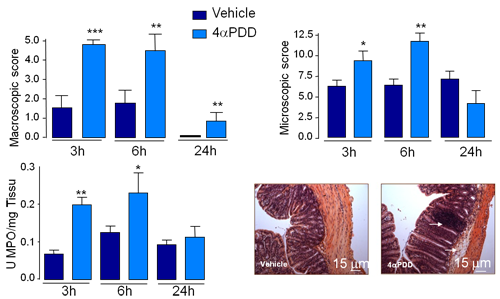Expression and functions of “Transient Receptor Potential Vanilloid 4” in intestinal epithelial cells: a new actor of inflammatory response
Emilie d’Aldebert
This work was performed under the supervision of Dr Nathalie Vergnolle
within unity INSERM U1043 CHU Purpan Toulouse.
Calcium is important in cell physiology, and therefore changes in its homeostasis can have serious consequences. Recent studies have highlighted a potential role of calcium channels in Inflammatory Bowel Disease (IBD). A recent study, revealed the role of one member of the “Transient Receptor Potential Vanilloid” (TRPV) family, the TRPV4, expressed on neurons, in visceral hypersensitivity (1). This study suggests a strong, TRPV4 expression, in the colonic mucosa of mice. Different mediators of inflammation can activate TRPV4, so it was important to study its role in intestinal inflammation and potentially on the intestinal epithelial cells.
We hypothesized that TRPV4 activation, specifically on intestinal epithelial cells, may result in pro-inflammatory signals, and therefore participate in the initiation and/or maintenance, of the inflammatory response in IBD.
Our first objective was to study the expression of TRPV4 in human intestinal epithelial cells (2). Then, as calcium influx plays an important role in IBD, we studied the function of TRPV4 on these epithelial cells. TRPV4 expression was strongly detected on epithelial and glial cells, from patients with or without IBD (Figure 1a). TRPV4 activation by 4αPDD, the specific agonist of TRPV4, in Caco-2 cells involved an increase of intracellular calcium concentration (Figure 1b) and relaease of IL-8 (Figure 1c). Therefore in those cells TRPV4 activates signalling pathways NF-kB and AP-1, resulting in the release of pro-inflammatory cytokines.
Figure 1 : Expression et functions of TRPV4 in intestinal epithelial cells
(a) Expression of TRPV4 in human intestinal epithelial cells (Immunohistochemistry of human resection) ; (b) Activation of TRPV4 in Caco-2 (intracellular calcium concentration, probe Fluo3) ; (c) Expression and release of IL- 8 in response to TRPV4 activation in Caco-2 cells (qRT-PCR and ELISA).

In vivo , intracolonic administration of the specific agonist of TRPV4, allowed us to demonstrate that its activation in the colon, causes an increase in inflammatory parameter (Figure 2).

Figure 2 : Intracolonic administration of 4αPDD caused colitis
Macroscopic damage score , microscopic damage score, myeloperoxidase activity (MPO), and H&E coloration of intestinal cells after administration of 4αPDD in colon of mice.
Highlighting the pro-inflammatory role of TRPV4 activation on intestinal epithelial cells, the second objective is to study the regulation of the activity of TRPV4. In an inflammatory context, many mediators are released and could regulate the functions of TRPV4 (3). Among these mediators, proteases appear to influence the response of many calcium channels. We focused our work on a possible regulation of TRPV4 activity by the activation of different Protease-Activated Receptor (PAR). Conversely, it seems interesting to see how mediators known to limit the inflammatory response and initiate a process of resolution, as hydrogen sulphide (H2S), can influence the cellular response to agonists of TRPV4. Activation of PAR1, PAR2 but not PAR4 potentiated the cellular response of TRPV4 but also activation of PAR2 sensitized the receptor, potentially enhancing its pro-inflammatory effects (Figure 3a). However, NaHS exposure decreased cellular response to TRPV4 agonist, thereby potentially exerting anti-inflammatory effects in the gut (Figure 3b).
Figure 3: Regulation of TRPV4 activity by inflammatory mediators

Our study shows that TRPV4 is expressed and functional on intestinal epithelial cells and its activation causes pro-inflammatory signals, which can be modulated by inflammatory mediators. TRPV4 can be considered as a new actor in the intestinal inflammatory response, may be responsible for the initiation and / or maintenance of inflammation observed in IBD.
(1)Cenac et al. Transient Receptor potential Vanilloid 4 has a major role in visceral hypersensitivity symptoms. Gastroenterology 2008. (2)d’Aldebert et al. Transient Receptor potential Vanilloid 4 activated inflammatory signals by intestinal epithelial cells and colitis in mice. Gastroenterology 2011. (3)d’Aldebert et al.Regulation of Transient Receptor Potentiel Vanilloid 4 activity by Protease Activated Receptor agonists and hydrogen sulfide in human intestinal epithelial cell lines. Unpublished data.
Home Page